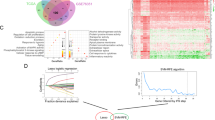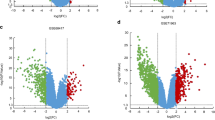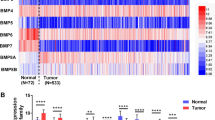Abstract
Clear cell renal cell carcinoma (ccRCC) is the most common type of renal cell carcinoma with high metastatic rate and high mortality rate, needing to find potential therapeutic targets and develop new therapy methods. The bioinformatics analysis was used in this study to find the targets. Firstly, the expression profile of ccRCC obtained from The Cancer Genome Atlas (TCGA) database and GSE53757 dataset were used to identify the significant up-regulated genes. IL20RB, AURKB and KIF18B with the top efficiency of capable of diagnosis ccRCC from para cancer tissue, were over-expressed in ccRCC samples, and expressed increasedly with the development of ccRCC. There was the closest correlation between AURKB and KIF18B in these three over-expressed genes. AURKB (high) or KIF18B (high) were all significantly correlated with higher T, N, M stage, G grade and shorter overall survival (OS) of ccRCC patients. Furthermore, the ccRCC patients with AURKB (high) + KIF18B (high) showed worse clinical characteristics and prognosis. Multivariate COX regression analysis indicated AURKB (high) and KIF18B (high) were all the independent prognostic risk factor without considering the interaction of AURKB and KIF18B. Moreover, considering the combination of each other, only AURKB (high) + KIF18B (high) expression was an independent prognostic risk factor for ccRCC patients, but not other situations. Collectively, AURKB was closely associated with KIF18B, and the combined expression of AURKB and KIF18B may be of great significance in ccRCC.




Similar content being viewed by others
Abbreviations
- ccRCC :
-
Clear cell renal cell carcinoma
- TCGA :
-
The Cancer Genome Atlas
- GEO :
-
Gene Expression Omnibus
- DEGs :
-
Differentially expressed genes
- ROC :
-
Receiver operating characteristic
- AUC :
-
Area under the curve
- OS :
-
Overall survival
References
Bray F, Ferlay J, Soerjomataram I, Siegel RL, Torre LA, Jemal A (2018) Global cancer statistics 2018: GLOBOCAN estimates of incidence and mortality worldwide for 36 cancers in 185 countries. CA Cancer J Clin 68(6):394–424
Hsieh JJ, Purdue MP, Signoretti S, Swanton C, Albiges L et al (2017) Renal cell carcinoma. Nat Rev Dis Primers 3(17009):9
Hsieh JJ, Le V, Cao D, Cheng EH, Creighton CJ (2018) Genomic classifications of renal cell carcinoma: a critical step towards the future application of personalized kidney cancer care with pan-omics precision. J Pathol 244(5):525–537
Li QK, Pavlovich CP, Zhang H, Kinsinger CR, Chan DW (2019) Challenges and opportunities in the proteomic characterization of clear cell renal cell carcinoma (ccRCC): a critical step towards the personalized care of renal cancers. Semin Cancer Biol 55:8–15
Capitanio U, Montorsi F (2016) Renal cancer. Lancet 387:894–906
Keefe SM, Nathanson KL, Rathmell WK (2013) The molecular biology of renal cell carcinoma. Semin Oncol 40(4):421–428
Fan Y, Ma X, Li H, Gao Y, Huang Q, Zhang Y, Bao X, du Q, Luo G, Liu K, Meng Q, Zhao C, Zhang X (2018) miR-122 promotes metastasis of clear-cell renal cell carcinoma by downregulating dicer. Int J Cancer 142(3):547–560
Cancer Genome Atlas Research N, Weinstein JN, Collisson EA, Mills GB, Shaw KR et al (2013) The cancer genome atlas Pan-Cancer analysis project. Nat Genet 45(10):1113–1120
Barrett T, Wilhite SE, Ledoux P, Evangelista C, Kim IF et al (2013) NCBI GEO: archive for functional genomics datasets-update. Nucleic Acids Res 41:D991–D995
Wang Z, Yang B, Zhang M, Guo W, Wu Z et al (2018) lncRNA epigenetic landscape analysis identifies EPIC1 as an oncogenic lncRNA that interacts with MYC and promotes cell-cycle progression in cancer. Cancer Cell 33(4):706–720
Li B, Wang W, Li Z, Chen Z, Zhi X, Xu J, Li Q, Wang L, Huang X, Wang L, Wei S, Sun G, Zhang X, He Z, Zhang L, Zhang D, Xu H, el-Rifai W, Xu Z (2017) MicroRNA-148a-3p enhances cisplatin cytotoxicity in gastric cancer through mitochondrial fission induction and cyto-protective autophagy suppression. Cancer Lett 410:212–227
Chen L, Yuan L, Qian K, Qian G, Zhu Y, Wu CL, Dan HC, Xiao Y, Wang X (2018) Identification of biomarkers associated with pathological stage and prognosis of clear cell renal cell carcinoma by co-expression network analysis. Front Physiol 9:399
Song J, Peng J, Zhu C, Bai G, Liu Y, Zhu J, Liu J (2018) Identification and validation of two novel prognostic lncRNAs in kidney renal clear cell carcinoma. Cell Physiol Biochem 48(6):2549–2562
Atkins MB, Tannir NM (2018) Current and emerging therapies for first-line treatment of metastatic clear cell renal cell carcinoma. Cancer Treat Rev 70:127–137
Shuch B, Amin A, Armstrong AJ, Eble JN, Ficarra V, Lopez-Beltran A, Martignoni G, Rini BI, Kutikov A (2015) Understanding pathologic variants of renal cell carcinoma: distilling therapeutic opportunities from biologic complexity. Eur Urol 67(1):85–97
Yan M, Wang C, He B, Yang M, Tong M et al (2016) Aurora-a kinase: a potent oncogene and target for cancer therapy. Med Res Rev 36(6):1036–1079
Al-Khafaji AS, Davies MP, Risk JM, Marcus MW, Koffa M et al (2017) Aurora B expression modulates paclitaxel response in non-small cell lung cancer. Br J Cancer 116(5):592–599
Enjoji M, Iida S, Sugita H, Ishikawa T, Uetake H et al (2009) BubR1 and AURKB overexpression are associated with a favorable prognosis in gastric cancer. Mol Med Rep 2(4):589–596
Lin ZZ, Jeng YM, Hu FC, Pan HW, Tsao HW, Lai PL, Lee PH, Cheng AL, Hsu HC (2010) Significance of Aurora B overexpression in hepatocellular carcinoma. Aurora B overexpression in HCC. BMC Cancer 10:461
ZhangY JC, Li H, Lv F, Li X et al (2015) Elevated Aurora B expression contributes to chemoresistance and poor prognosis in breast cancer. Int J Clin Exp Pathol 8(1):751–757
Chen YJ, Chen CM, Twu NF, Yen MS, Lai CR, Wu HH, Wang PH, Yuan CC (2009) Overexpression of Aurora B is associated with poor prognosis in epithelial ovarian cancer patients. Virchows Arch 455(5):431–440
Lens SM, Voest EE, Medema RH (2010) Shared and separate functions of polo-like kinases and aurora kinases in cancer. Nat Rev Cancer 10(12):825–841
Tang A, Gao K, Chu L, Zhang R, Yang J et al (2017) Aurora kinases: novel therapy targets in cancers. Oncotarget 8(14):23937–23954
Lok W, Klein RQ, Saif MW (2010) Aurora kinase inhibitors as anti-cancer therapy. Anti-Cancer Drugs 21(4):339–350
Sehdev V, Peng D, Soutto M, Washington MK, Revetta F, Ecsedy J, Zaika A, Rau TT, Schneider-Stock R, Belkhiri A, el-Rifai W (2012) The aurora kinase A inhibitor MLN8237 enhances cisplatin-induced cell death in esophageal adenocarcinoma cells. Mol Cancer Ther 11(3):763–774
Cheung CH, Sarvagalla S, Lee JY, Huang YC, Coumar MS (2014) Aurora kinase inhibitor patents and agents in clinical testing: an update (2011-2013). Expert Opin Ther Pat 24(9):1021–1038
Schwartz GK, Carvajal RD, Midgley R, Rodig SJ, Stockman PK, Ataman O, Wilson D, Das S, Shapiro GI (2013) Phase I study of barasertib (AZD1152), a selective inhibitor of Aurora B kinase, in patients with advanced solid tumors. Investig New Drugs 31(2):370–380
Yu Y, Feng YM (2010) The role of kinesin family proteins in tumorigenesis and progression: potential biomarkers and molecular targets for cancer therapy. Cancer 116(22):5150–5160
Lee YM, Kim E, Park M, Moon E, Ahn SM, Kim W, Hwang KB, Kim YK, Choi W, Kim W (2010) Cell cycle-regulated expression and subcellular localization of a kinesin-8 member human KIF18B. Gene 466(1–2):16–25
Wu Y, Wang A, Zhu B, Huang J, Lu E (2018) KIF18B promotes tumor progression through activating the Wnt/β-catenin pathway in cervical cancer. Onco Targets Ther 11:1707–1720
Itzel T, Scholz P, Maass T, Krupp M, Marquardt JU, Strand S, Becker D, Staib F, Binder H, Roessler S, Wang XW, Thorgeirsson S, Müller M, Galle PR, Teufel A (2015) Translating bioinformatics in oncology: guilt-by-profiling analysis and identification of KIF18B and CDCA3 as novel driver genes in carcinogenesis. Bioinformatics 31(2):216–224
Tanenbaum ME, Macurek L, van der Vaart B, Galli M, Akhmanova A, Medema RH (2011) A complex of Kif18b and MCAK promotes microtubule depolymerization and is negatively regulated by Aurora kinases. Curr Biol 21(16):1356–1365
Acknowledgements
This research was funded by the National Natural Science Foundation of China (No. 81601370), the Construction of Translational Medicine Research Center and Collaborative Network in the Area of Bladder Diseases of Liaoning Province (No. 2015225009), the National Natural Science Foundation of China and Liaoning joint fund key program (No. U1608281) and the Double Hundred Program for Shenyang Scientific and Technological Innovation Projects (No. 100040).
Author information
Authors and Affiliations
Corresponding authors
Ethics declarations
Conflict of Interest
The authors declare that they have no known competing financial interests or personal relationships that could have appeared to influence the work reported in this paper.
Additional information
Publisher’s Note
Springer Nature remains neutral with regard to jurisdictional claims in published maps and institutional affiliations.
Rights and permissions
About this article
Cite this article
Liu, Q., Zhang, X., Tang, H. et al. Bioinformatics Analysis Suggests the Combined Expression of AURKB and KIF18B Being an Important Event in the Development of Clear Cell Renal Cell Carcinoma. Pathol. Oncol. Res. 26, 1583–1594 (2020). https://doi.org/10.1007/s12253-019-00740-y
Received:
Accepted:
Published:
Issue Date:
DOI: https://doi.org/10.1007/s12253-019-00740-y




